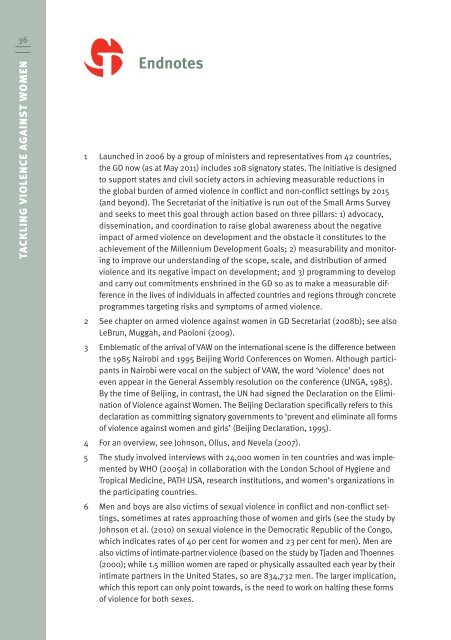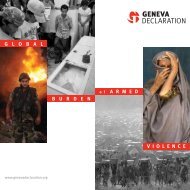Tackling Violence against Women: From Knowledge to Practical
Tackling Violence against Women: From Knowledge to Practical
Tackling Violence against Women: From Knowledge to Practical
Create successful ePaper yourself
Turn your PDF publications into a flip-book with our unique Google optimized e-Paper software.
36<br />
TAckliNG ViolENcE AGAiNsT WomEN<br />
Endnotes<br />
1 Launched in 2006 by a group of ministers and representatives from 42 countries,<br />
the gD now (as at May 2011) includes 108 signa<strong>to</strong>ry states. The initiative is designed<br />
<strong>to</strong> support states and civil society ac<strong>to</strong>rs in achieving measurable reductions in<br />
the global burden of armed violence in conflict and non-conflict settings by 2015<br />
(and beyond). The Secretariat of the initiative is run out of the Small Arms Survey<br />
and seeks <strong>to</strong> meet this goal through action based on three pillars: 1) advocacy,<br />
dissemination, and coordination <strong>to</strong> raise global awareness about the negative<br />
impact of armed violence on development and the obstacle it constitutes <strong>to</strong> the<br />
achievement of the Millennium Development goals; 2) measurability and moni<strong>to</strong>ring<br />
<strong>to</strong> improve our understanding of the scope, scale, and distribution of armed<br />
violence and its negative impact on development; and 3) programming <strong>to</strong> develop<br />
and carry out commitments enshrined in the gD so as <strong>to</strong> make a measurable difference<br />
in the lives of individuals in affected countries and regions through concrete<br />
programmes targeting risks and symp<strong>to</strong>ms of armed violence.<br />
2 See chapter on armed violence <strong>against</strong> women in gD Secretariat (2008b); see also<br />
LeBrun, Muggah, and paoloni (2009).<br />
3 Emblematic of the arrival of VAw on the international scene is the difference between<br />
the 1985 Nairobi and 1995 Beijing world Conferences on women. Although participants<br />
in Nairobi were vocal on the subject of VAw, the word ‘violence’ does not<br />
even appear in the general Assembly resolution on the conference (UNgA, 1985).<br />
By the time of Beijing, in contrast, the UN had signed the Declaration on the Elimination<br />
of <strong>Violence</strong> <strong>against</strong> women. The Beijing Declaration specifically refers <strong>to</strong> this<br />
declaration as committing signa<strong>to</strong>ry governments <strong>to</strong> ‘prevent and eliminate all forms<br />
of violence <strong>against</strong> women and girls’ (Beijing Declaration, 1995).<br />
4 For an overview, see Johnson, Ollus, and Nevela (2007).<br />
5 The study involved interviews with 24,000 women in ten countries and was implemented<br />
by wHO (2005a) in collaboration with the London School of Hygiene and<br />
Tropical Medicine, pATH USA, research institutions, and women’s organizations in<br />
the participating countries.<br />
6 Men and boys are also victims of sexual violence in conflict and non-conflict settings,<br />
sometimes at rates approaching those of women and girls (see the study by<br />
Johnson et al. (2010) on sexual violence in the Democratic Republic of the Congo,<br />
which indicates rates of 40 per cent for women and 23 per cent for men). Men are<br />
also victims of intimate-partner violence (based on the study by Tjaden and Thoennes<br />
(2000); while 1.5 million women are raped or physically assaulted each year by their<br />
intimate partners in the United States, so are 834,732 men. The larger implication,<br />
which this report can only point <strong>to</strong>wards, is the need <strong>to</strong> work on halting these forms<br />
of violence for both sexes.









